Fiscal deficit, constraints in tax base expansion and weakening of institutional mechanism are challenges
Fiscal deficit, constraints in tax base expansion and weakening of institutional mechanism are challenges
The health of municipal finances is an important element of municipal governance that will determine whether India delivers on its economic and developmental promise. The 74th Constitutional Amendment Act was passed in 1992 which mandated the establishment of Urban Local Bodies (ULBs) as the lowest unit of governance in cities and towns and devolution of powers. Constitutional provisions were made for financial empowerment of urban local bodies. However, three decades on, the rising fiscal deficit, constraints on expanding the tax base and weakening of the institutional mechanisms capable of mobilizing resources remain challenges. The loss of revenue after the imposition of the Goods and Services Tax (GST) and the pandemic has aggravated the situation.
Comprehensive data sets on municipal finance are important for understanding and countering these challenges, but few exist at the city level. Recently, the Indian Institute for Human Settlements (IIHS) analyzed data from 80 ULBs across 24 states between 2012-13 and 2016-17 to understand ULB finance and spending and found some key trends.
own revenue share
First, ULBs’ own revenue sources accounted for less than half of their total revenues, with huge untapped potential. The major revenue sources of ULBs are taxes, fees, fines and fees, and transfers from the central and state governments, known as inter-government transfers (IGTs). The share of own revenue in total revenue (including revenue from taxes on property and advertisements, and non-tax revenue from user fees and fees from building permits and business licenses) is an important indicator of a ULB’s financial health and autonomy. This ratio reflects the ability of ULBs to utilize the sources and their dependence on IGT which they are entitled to tap. Cities with a higher share of their own revenue are more economically self-sufficient.
Our study found that the own revenue of ULBs was 47% of their total revenue. Of this, tax revenue was the largest component: about 29% of the total. Own revenue grew by 7% from 2012-13 to 2016-17, but ULBs still lacked revenue buoyancy as their share of own revenues in GDP was only 0.5% for the five-year period .
Structure of Revenue Receipts for the Year 2016-2017 from Estimates of Data of 80 Urban Local Bodies studied. Source: IIHS, 2022
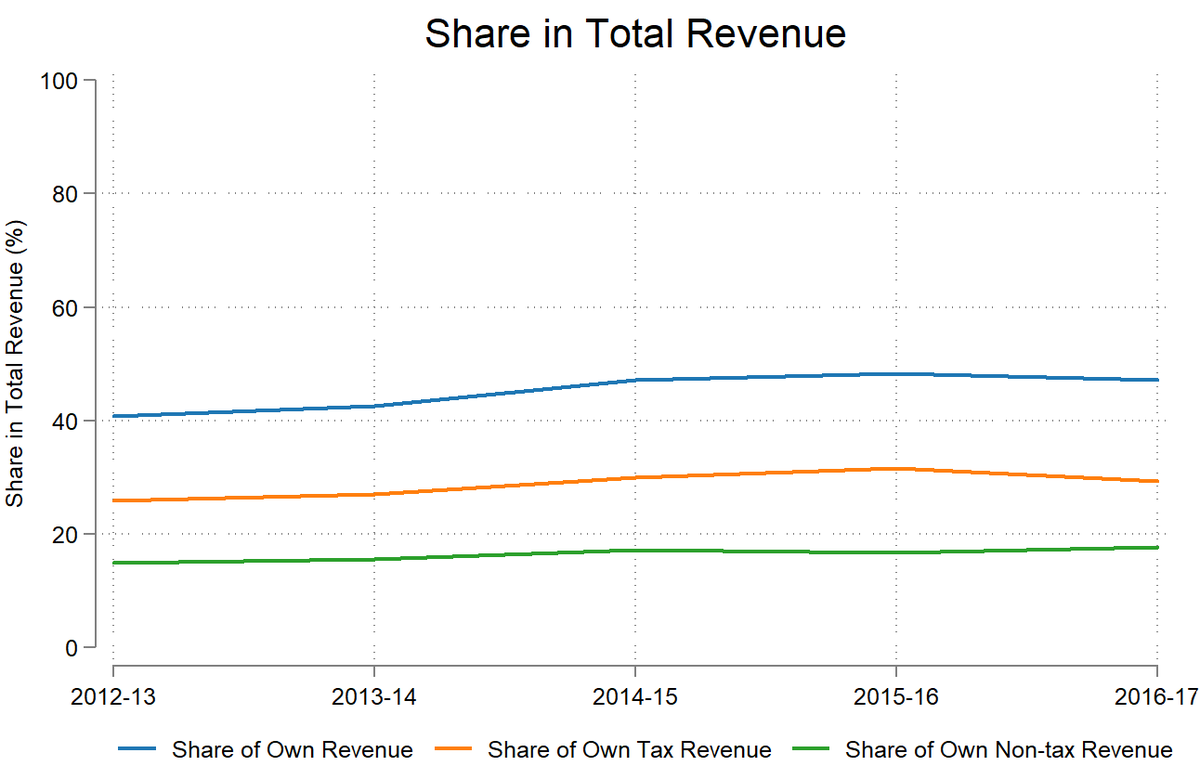
The share of total revenue in the years 2012-13 to 2016-17 estimated from the data of 80 ULBs studied. Source: IIHS, 2022
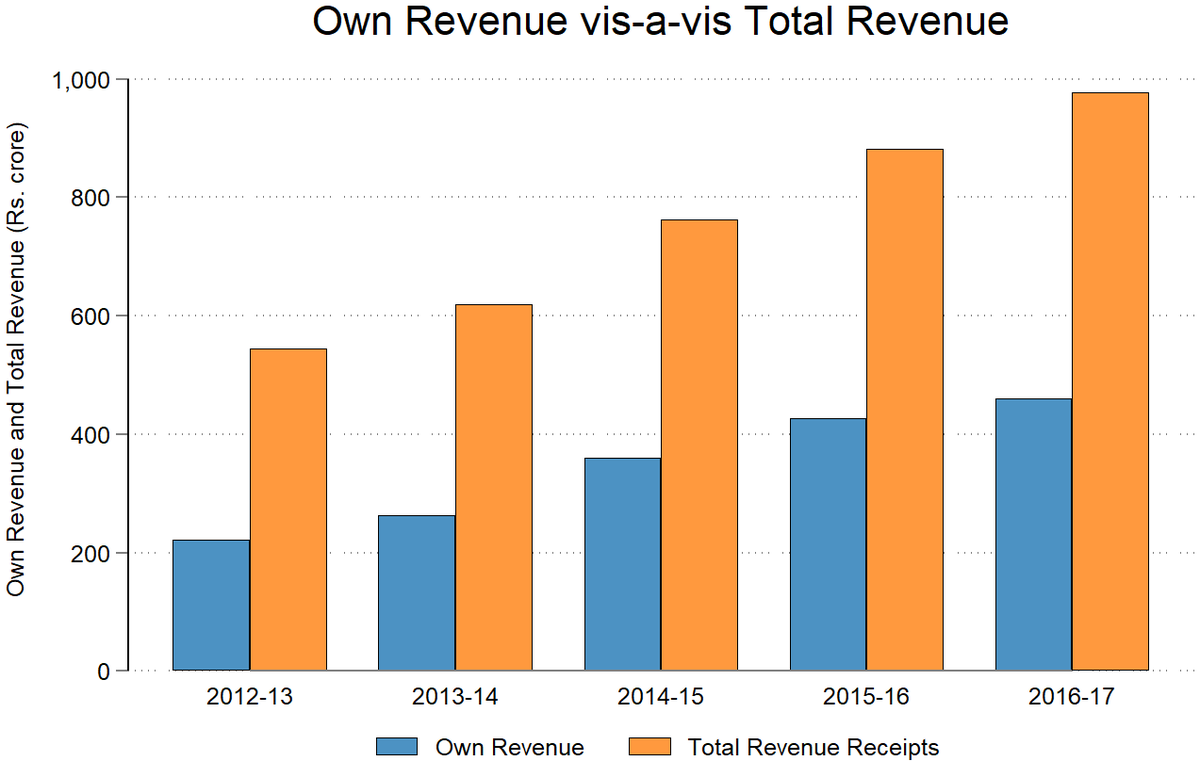
Graph showing a comparison of self review versus total revenue for the years 2012-13 to 2016-17 based on estimates of 80 ULBs. Source: IIHS 2022
Wealth taxes, the largest contributor to ULBs’ own revenue, account for only 0.15% of GDP. The relevant figures for developing and developed countries were significantly higher (0.6 percent and 1%, respectively), indicating that India’s potential is under-utilised. Estimates suggest that Indian urban local bodies can achieve these levels. It is essential that urban local bodies leverage their own revenue raising powers to be financially sustainable and empowered and have better facilities and quality of service delivery.
dependent on IGT
Second, many ULBs were highly dependent on IGT. Transfers from the central government are determined by central finance commissions and through grants for specific reforms, while state government transfers are in the form of transfers of grants-in-aid and collection of state local taxes. Most ULBs were heavily dependent on external grants – between 2012-13 and 2016-17, IGT accounted for about 40% of the total revenue of ULBs.
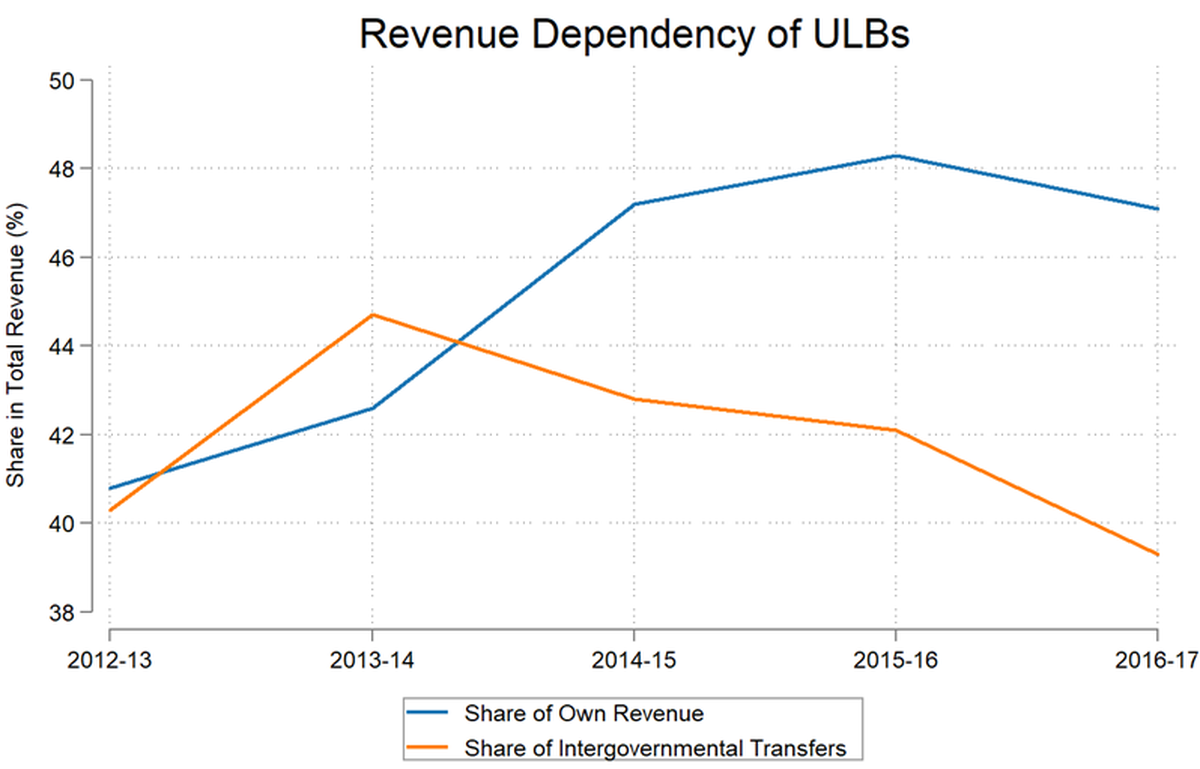
Graph showing a comparison of revenue through intergovernmental transfer versus own revenue using data analyzed from 80 ULBs. Source: IIHS, 2022
Stable and predictable IGT is especially important as the ULB’s own revenue collection is inadequate. While the dependence on IGT decreased over the years due to a modest increase in own revenue, the scale of IGT in India stood at about 0.5% of GDP, much lower than the international average of 2% to 5% of GDP .
This can be rectified by increasing the revenue assigned to ULBs from state governments and allocating a portion of state and central GST income to ULBs. This will reduce the balance sheet of ULBs as they raise their own revenue and explore market-based instruments. IGTs can also encourage ULBs to provide better service quality and maintain financial discipline.
Third, tax revenue is the biggest revenue source for large cities, while smaller cities are more dependent on grants. There is considerable variation in the composition of revenue sources in different sized cities. Category IA cities (population above 50 lakh) mainly depend on their own tax revenue, while class IB cities and class IC cities (population of 10 lakh-50 lakh and 1 lakh-10 lakh respectively) on IGT are more dependent.
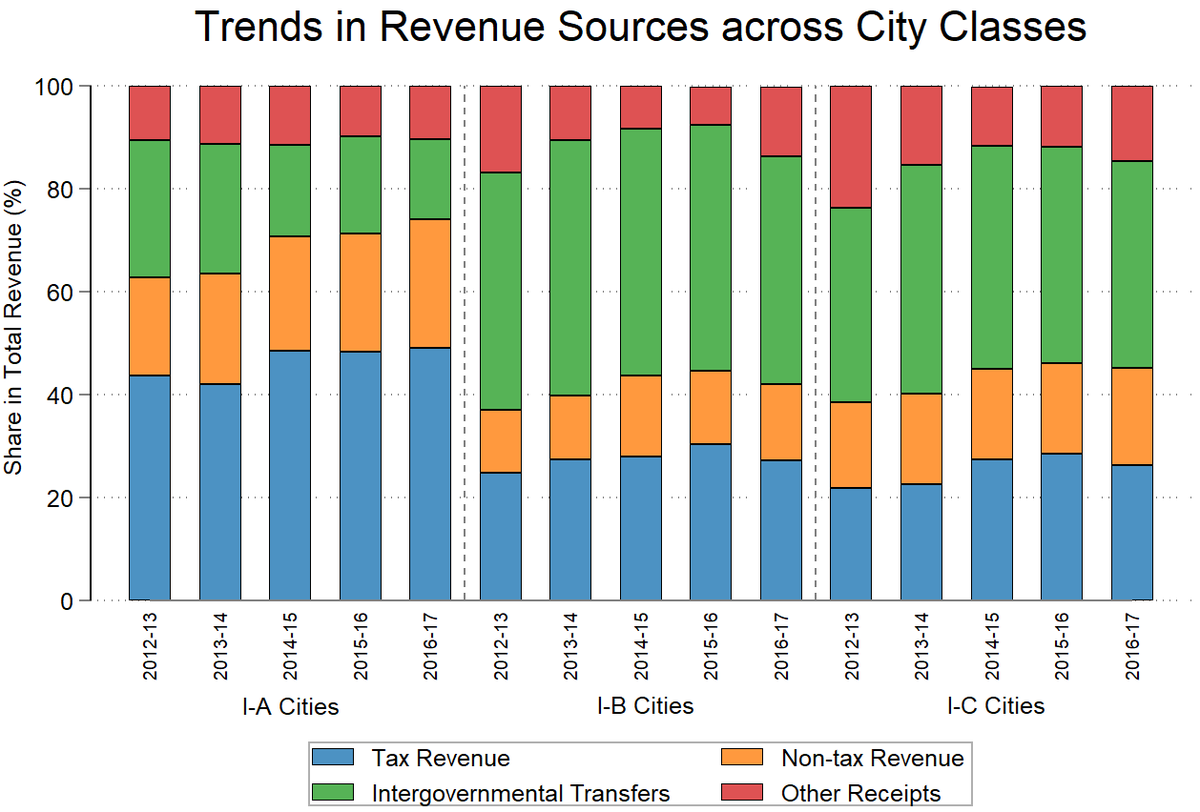
Trends in revenue sources across city sections, based on estimates from data for 80 ULBs. Source: IIHS, 2022
There was a substantial increase in own revenue collection in Category IA cities. This was primarily driven by growth in non-tax revenue. Over the five-year period studied, tax revenue in Category IA cities increased by about 11%, while non-tax revenue increased by about 30%. The external revenue dependence of these large cities gradually decreased over time, from around 27% in 2012-13 to around 15% in 2016-17. Class IB and Class IC cities, on the other hand, had their own revenues stable despite the increase in the size of these cities.
operation and maintenance
Fourth, operating and maintenance (O&M) expenses are rising but are still insufficient. O&M expenses are critical for maintaining infrastructure and maintaining quality of service delivery. The share of O&M expenditure in the total revenue expenditure of ULBs increased from about 30% in 2012-13 to about 35% in 2016-17. While expenses were rising, studies (such as ICRIER, 2019 and Bandyopadhyay, 2014) indicate that they remained insufficient. For example, O&M expenses incurred in 2016-17 covered about one-fifth of the requirement forecast by the high-powered expert committee to estimate investment requirements for urban infrastructure services.
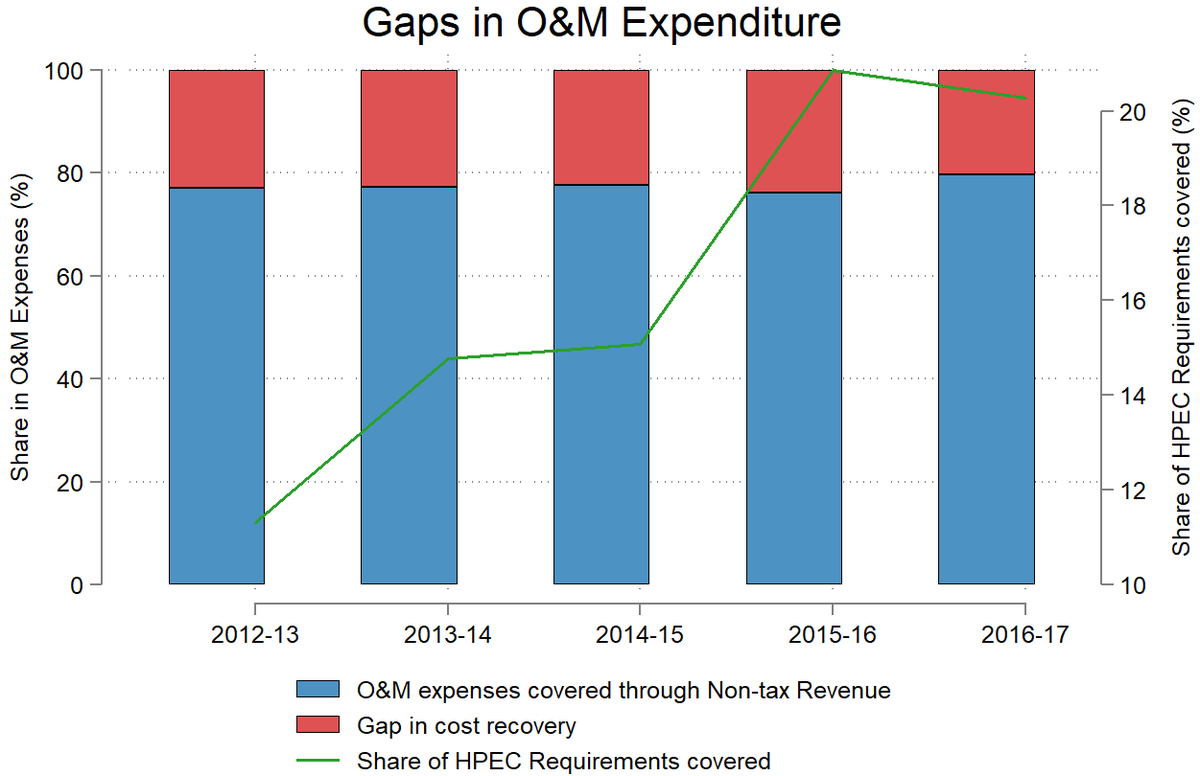
Comparison of gap years in operation and maintenance expenditure using data on 80 ULBs in India. Source: IIHS 2022
O&M expenses should ideally be covered through user fees, but the total non-tax revenues, of which user fees are a part, are insufficient to meet current O&M expenses. Thus cost recovery for services such as water supply, solid waste management, transportation and wastewater management is clearly inadequate.
Non-tax revenue was less than O&M expenditure by about 20%, and this shortfall contributed to the growing revenue deficit in urban local bodies. Increasing the level of cost recovery through better user fee regime will not only improve the services but will also contribute to the financial vitality of the Urban Local Bodies.
The scale of municipal finance in India is undoubtedly inadequate. A ULB’s own revenue resources are much less than the projected capacity. Tapping into property taxes, other land-based resources and user charges are all ways to improve a ULB’s revenue. IGT plays an important role in the financial structure of ULBs, and a steady support from the central and state governments is crucial until ULBs improve their own revenues. Measures also need to be taken to cover O&M expenses of ULBs for better infrastructure and service.
Amir Bajaj is Senior Lead and Associate Dean of the School of Environment and Sustainability and Madhumita Srinivasan is Research Assistant at IIHS. Manish Dubey, Head of Exercise Program at IIHS contributed to the article